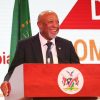
play_arrow
keyboard_arrow_right
Omanyano ovanhu koikundaneki yomalungula kashili paveta, Commisiner Sakaria takunghilile
Veronika Haulenga
Omanyano ovanhu koikundaneki yomalungula kashili paveta, Commisiner Sakaria takunghilile
Veronika Haulenga
Listeners:
Top listeners:
00:00
00:00
volume_up
chevron_left
-
play_arrow
Omanyano ovanhu koikundaneki yomalungula kashili paveta, Commisiner Sakaria takunghilile Veronika Haulenga
The zero draft to create a pact for the future has landed. The hard part begins.

share
close
The zero draft of the Pact for the Future — the agreement to seal September’s much-anticipated Summit of the Future — was introduced recently by the co-facilitators, Namibia and Germany, to fellow members at the United Nations. The draft is the fruition of careful consideration, balancing an array of diverse aspirations from all 193 member states.
It is built on the proposals made in Secretary-General António Guterres’s Our Common Agenda and related 11 policy briefs, as well as the report of the High-Level Advisory Board on Effective Multilateralism. The draft reinforces numerous points of agreement reached during and before last September’s SDG Summit. To their credit, the Namibian and German negotiators encouraged other parties from beyond governments to respond, attracting more than 500 contributions worldwide.
Why is the draft so important? It plants the seed toward instituting much-needed progress in how the world is governed. Some say this is not the time for global governance reform, that the world is far too divided. On the contrary, it is vital that we take responsibility to counter the forces of disintegration — and the UN must lead in this regard. It is imperative that the UN is empowered to move this agenda ahead.
Germany and Namibia must be aspirational yet practical, forward thinking but attuned to present realities, ambitious but politically feasible. The way to strike such a sensitive balance is for the member states to understand the current challenges, to learn from the past 79 years of the UN’s life span and to project those lessons out a century from now. What steps will be taken at the September summit to set us on that positive path?
The draft can be a constructive point of departure to reach more ambitious levels of agreement. We are pleased to see robust recommendations regarding meaningful youth engagement in its dedicated chapter as well as the treatment of emerging technology — including lethal autonomous weapons — in the peace chapter. But this is just a start.
The Coalition for the UN We Need, which last year produced an interim people’s pact before the five chapters of the Pact for the Future were finalized, supports the principles articulated in the draft. It is also consistent with the Coalition’s open letter on the UN Summit of the Future, signed by more than 50 eminent people worldwide who called on governments to “scale up their commitments and collaboration, taking a long-term perspective to bring about a world that is more equitable, inclusive, secure and sustainable.”
As promised, the draft commits member states to the principles of human rights and gender equality. Vitally, the pact suggests that member states “commit to concrete steps to reinvigorate this system, fill critical gaps in global governance, and accelerate efforts to keep our past promises and agreements.” This focus will represent the work of the next seven months.
For people who have followed the preparations for the Summit, there are not many new substantive initiatives in the draft. Most of the text reflects internationally agreed language, without committing to specific governance reforms. Repeated phrases, such as “We commit to further developing . . .” and “We will work together to improve . . .” indicate a direction for improving international cooperation, but with the all-important details to be worked out in negotiations before the Summit or during the proposed two-year implementation period (with a stocktaking of progress on reform commitments to be held at the end of the General Assembly’s 80th session, in 2026 ).
One interesting note from the co-facilitators in the draft section on “Transforming Global Governance” indicates an intention to provide initial language for proposed Security Council reform by June 2024.
Fully aware of current political sensitivities, it is now time for civil society to engage member states as constructive partners more formally. Such active participation can catalyze the level of agreement and ambition among governments.
The next steps we propose:
• Generate excitement, political will and public support for cooperative and creative global solutions. Because of the daunting polycrisis we face, this can ensure a valuable outcome.
• Work with a wide range of experts to flesh out additional innovations, consistent with the “new approach” underscored in the draft. These could range from such low-hanging fruit as gender alternation of the president of the General Assembly to more aspirational calls, like enhancing the UN Environment Program and annual climate COPs or upgrading the Peacebuilding Commission into an empowered Peacebuilding Council.
• Build greater trust in the negotiations by allowing civil society access to the proceedings. This will help all diplomats as they forge a common ground, while providing citizens a window into an intergovernmental process.
• As the draft expresses, set in motion efforts “to review progress on the implementation of the commitments in this Pact.” This could go further, in line with a core recommendation of the Secretary-General’s High-Level Advisory Board on Effective Multilateralism to include a call for an a UN Charter review conference.
The draft represents a promising start upon which to build a successful Summit of the Future.
Written by: Contributed
Civil Society climate COPs Diplomacy gender equality Germany Global Governance human rights International Cooperation Namibia Pact for the Future Peacebuilding Commission Peacebuilding Council policy briefs Security Council reform UN
Rate it
Similar posts
Windhoek Weather
Most popular

Mbumba signs off new benefits for retired political office bearers

Former FNB employee arrested after defraud pensioner off N$215, 000

Namdia Heist: More questions, lots of confusion

Omuhwahwameki Michael okuunganeka oshikonga shoku patitha oostola dho Rani moshilongo ashihe.

Windhoek woman loses N$60,000 to fraudsters
Copyright 2025 Future Media (Pty) Ltd | Website by Digital Platforms
Tel: +264 83 000 1000 | Email: news@futuremedia.com.na





